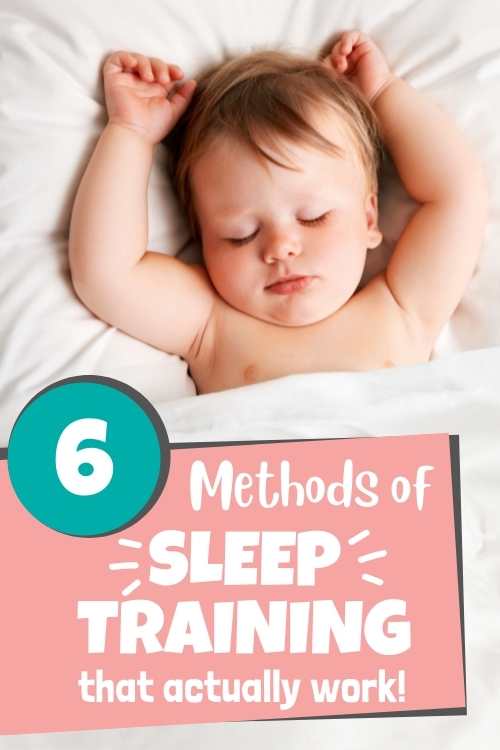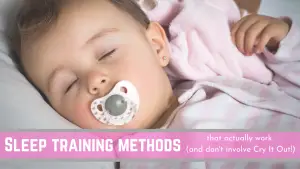Yes, you read right. Sleep training methods that DO NOT involve Cry It Out! I had to put that on the title, and give some comfort to whoever is looking at sleep training their baby that cry it out (CIO) is not the only method. For some reason when new parents think of sleep training, they seem to associate it straight away to letting your child cry until they fall asleep. That is so not true!
If you are considering the Cry It Out method, make sure to check out these DOs and DON’Ts, and also how your baby’s temperament affects the sleep training.
Before I dive deep into the different sleep training methods, I want to shed some light on what sleep training actually means, as there seems to be a lot of confusion amongst parents as to what it is. Understanding the meaning of sleep training will help so much when going through the different methods and it will not create any unrealistic expectations of how long your baby should be sleeping at night.
Related: Baby waking up multiple times a night: here’s what you need to know.

Sleep Training Explained
Sleep training could have a million different definitions depending on who you talk to. And for most people it’s about teaching your baby to sleep 12 hours straight at night. Gosh, I wish it was that easy for everybody! But, unfortunately, that is not it. And not all babies can get there, at least not for a while.
I personally think this is the best definition:
Sleep training teaches your child to fall asleep independently, without sleep aids, such as nursing to sleep, rocking, the use of a pacifier, etc.
Christine Keys
In essence, sleep training provides your baby with the tools to fall asleep all by themselves (also called self-settling). Meaning that, unless your baby is uncomfortable or hungry, they should be able to drift off to sleep again in between sleep cycles.
Another definition that I really love is this one:
Sleep training is the act of teaching your baby healthy sleep habits applicable to their current age that he or she will be able to use for the rest of their lives. What “success” looks will vary from baby to baby and family to family.
The Baby Sleep Site
This will probably make more sense when you read the paragraph below on “Know when your Baby is Ready“. Not all babies can or will sleep through the night until they are a bit older, and that’s OK. It can be hard for a while, but it doesn’t mean they are bed sleepers. I often find that adjusting our expectations as parents is what really determines our “success”.
Why you should Sleep Train
Sleep training is 100% your choice. If your baby wakes up every 2 hours at night for a feed and you are comfortable with that, nobody is telling you that you should change that. However, know that babies that do not have a good night sleep tend to be grumpier during the day, eat less and struggle falling asleep the following night because they are overtired. It becomes a vicious circle.
I mean, think of you as an adult: how do you feel after a crap night when you woke up multiple times?! And I am guessing, if you are reading this post, you know what I am talking about!
Sleep deprivation is real, and the same thing happens to babies. So, sleep training is not just for the exhausted parents, so they can finally have a good night sleep. It’s for the baby’s well-being as well!
Related: 8 Tips for New Parents to Avoid Sleep Deprivation

When you should Sleep Train
The sweet spot for sleep training is around 4 to 6 months. Before that, babies still need to wake up frequently for feeds, and their sleep patterns are quite irregular. However, around 4 months old, the baby’s brain goes through quite a significant development milestone, during which the baby sleep pattern becomes more similar to the one of an adult.
Also, around this age, if your baby is not able to put themselves back to sleep, they will cry until they are given that sleep association they are accustomed to again (that be rocking, dummy, etc.), even if they are not hungry! However, they are still still young enough not to be too aware of these sleep associations. Meaning, they will not need or want them so desperately to scream for them for too long.
Lots of parents, myself included, who had a child that used to sleep for 8 hours straight at night, find themselves having to put their baby back to sleep every 2 hours at around 4 months! This is called the 4-month sleep regression, and you can read more tips and information on how to tackle it over here.
On the other hand, when the baby reaches the 6 months old mark, they will become way more aware and extremely hard to settle if you don’t give them what soothes them to go to sleep. This is when sleep training gets much harder.
Related: 4 Month Sleep Regression: why it is the most important one to get right!
Know when your Baby is Ready
I need to add a side note here: remember that all babies are different and if your friend’s baby is sleeping 12 hours at night, it doesn’t mean your baby is ready to do the same!
I think it’s very easy to get caught up in other parents’ “success stories”. Parents love to brag about their child sleeping through the night. But let me tell you something from experience: I know so many parents that used to have babies sleeping the whole night, that then turned up having 3 years old getting out of bed multiple times at night. You are all in for the long run.
Plus, sleep exhaustion is real and the modern world we live in definitely doesn’t work in favor of new parents. So, when starting to sleep train, we are all looking for a miracle. I remember when Daniela, my first daughter, was 6 months old and still waking up a couple of times a night for a feed. She would then sleep until 7 am, by my alarm clock to go to work was at 5.30 am. Not fair! I used to be so tired going into work. And that can really affect your judgement and behavior when sleep training.
Remember your little one is doing the best that they can, and they might not be ready to drop all their feeds at night, even if you are sleep training. Physiologically, they may still need a feed at night until they are 9/10 months old, when they are well established on solids and eating 3 meals a day.

6 Sleep Training Methods that Actually Work
The sleep training methods listed below can be classified into two different groups:
- Gentle Sleep Training Methods: these do not involve lots of crying
- Sleep training methods that involve some crying:
I should point out that with any form of sleep training you are inevitably going to encounter some form of protest and crying, as you are going to change the rules of how your baby falls asleep! If they are used to falling asleep with you rocking them, feeding them or with any other form of sleep association, and then you start taking this association away, they will need time to adjust to this new routine.
1) Gentle Sleep Training Methods
The Four S’s Sleep Training Method
The 4 S’s Sleep Training Method is based on the book The Baby Whisperer Solves All Your Problems by Tracy Hogg. This method focuses on recognizing the right cues to know when your child is tired and the importance of a winding down period, which gives the baby a chance to transition from activity to sleep time.
The process (4 S’s) involves:
- Setting the stage: the baby needs to have a solid and consistent bedtime routine that happens at the same time every day
- Swaddling: you should always swaddle your baby, even if they don’t seem to enjoy it
- Sitting: once you’ve swaddled your baby, you should sit with them in a vertical position. Do not rock them. Only put them in their crib once they are relaxed, but not asleep yet.
- Shush-Pat: if they cry when you put them down, you should whisper: “shh, shh, shh, shh” while patting their back.
This method is great because it teaches your baby to fall asleep on their own from when they are very little without certain sleep associations, such as rocking. You can read a success story about this method from The Babywise Mom here.
The downside is that it only works for very little babies that can be (and want to be!) swaddled: usually babies that are younger than 4-6 months. After that, you need to look at other sleep training methods. Also, swaddling can easily become a sleep association as well, which means that you still need to sleep train them afterwards to teach the out to fall asleep without it.
The Pick-Up-Put-Down (PUPD) Sleep Training Method
The PUPD method works by putting your baby down in the crib or bassinet drowsy but awake. If or when they cry, you need to pick them up and comfort them until they are calm and drowsy again. Then, you put them back down. You need to repeat this cycle until they are finally asleep.
I have personally tried this method and it does work involving very minimal tears. However, it does take a long time and it requires quite a lot of patience, particularly at night! Depending on how your baby reacts, you really need to be ready for some long nights with this methods and be in the right frame of mind, so that you keep being consistent and don’t start changing your approach just because you are too tired.
While this sleep training method can be effective at any age, it can be quite challenging with an older baby that becomes heavier to pick up multiple times.
Also, it won’t work for every baby. Some babies find being picked up and put down so often over-stimulating, and they gradually become frustrated and worked up, instead of relaxed. If this becomes the case with your baby, I recommend switching to another sleep training method.

The Fading (FIO) Sleep Training Method
The Fading Method consists in the gradual fading out of a sleep association like rocking or feeding. With this method, you continue to help your baby fall asleep but, over time, you gradually reduce and then stop doing it.
For example, if you are used to rocking your baby to sleep, you could shorten the amount of time you rock each night until you don’t do it anymore, or you just do it to relax your baby before you put them down awake (not asleep). Eventually, your baby won’t need that sleep association anymore and will be able to fall asleep by themselves.
This method really minimizes crying a lot compared to the other methods. However, similarly to the PUPD method, it does require a lot of patience. It can also work with any age, but the older the baby, the longer it takes to work usually.
I have personally used this method, together with the PUPD method, with my second baby when she went through the 4 month sleep regression. I used to feed her to sleep, so I had to stop feeding her before going to sleep and I started rocking her instead. I gradually reduced the amount of time I was rocking her, but I also had to pick her up and put her back down a few times before she would settle by herself.
You can read more about the 4 month sleep regression
The Chair Method, or Sleep Lady Shuffle Sleep Training Method
This method consists in a parent sitting in a chair near the crib, until their baby falls asleep. Gradually, the parent moves farther and farther away from the crib until they are right outside the door. Eventually, they will no longer need the chair at all.
According to the Baby Sleep Site, the goal is not to help your child fall asleep, nor to help them calm down. You are not supposed to give them attention. The reason you are in the chair is only to reassure them that you are there with them. For this reason, this method works best for mild-mannered babies, who just need a little bit of security of having their parent in the room with them. For other babies, this method can be quite difficult and can take a very long time.
It can also be very difficult to avoid engaging with your child as they start crying. Or it can be a little confusing for the child when you don’t interact. Some children even react by getting more upset if you are in the room! However, it can be a good option for parents who do not want to leave their child alone as they start crying.
There are variations to this method, like Kim West’s Sleep Lady Shuffle, where you do attend to the baby periodically, verbally and/or physically, and then go back to your chair. This is what I have personally done with my first daughter, it was just too hard to sit there and listen to her cry, so I would pat her or pick her up and put her back down, util she learned to settle. Also, I couldn’t fit a chair in her room, so I just sat on the floor or stood by the side of the crib and gradually moved away.
Too bad that when she learned how to get out of bed, and kept coming out throughout the night, I couldn’t use this method anymore!
Remember, finding what works best for you and your child is key!
2) Other Sleep Training Methods
The Three-Minute Drill Sleep Training Method
The Three-Minute Drill sleep training method allows the parents to be involved, without requiring the constant involvement that pick up / put down and the chair method require.
It consists in putting your baby to bed in the crib while still awake and leaving the room. You are going to stay outside of the room and listen to your baby. If (or more like “when”!) they begin to cry, wait until the cry reaches a loud “level 10”. This is the desperate cry that says “I want to get out of here!”, which is different from the cry from when they are hurt or in pain. Once they reach “level 10”, wait for 3 minutes.
If, at any point during those 3 minutes, the cry reduces to a whimper, stop the timer. Only restart it if and when the cry elevates to the level 10 again. Only do this for three consecutive times though: after the third level-10 cry, you can stop the timer and go in the baby’s room to soothe them.
When you go into the room you can give them some comfort and reassurance by saying “shh shh” or patting them on the back. Try to avoid picking them up, which will be very hard! Keep it short for about 10-20 seconds and then leave the room again.
Restart your timer and repeat the process until your baby falls asleep. If your baby wakes up in the middle of the night, you will start your timer and repeat the process again. As this happens over and over again, your baby will learn to self-settle.
I tried this method with my first daughter and, let me tell you, it can be so hard! Those 3 minutes can really feel like an eternity! It is supposed to be good for the parents who are okay with a little bit of crying, but don’t want to let their baby cry for too long. And I used to like the idea that there was a set time of 3 minutes. However, we found that our daughter used to escalate to level-10 (and beyond) extremely quickly, and 10-20 seconds definitely weren’t enough to calm her down when we were going back into the room. On the contrary, going in the room seemed to upset her even more. It was too hard for us, so we decided to look into other sleep training methods.
The Ferber, or Controlled Crying Sleep Training Method
The Ferber or Controlled Crying method is not the same as CIO, but it can be fairly similar. It became quite popular thanks to the book Solve Your Child’s Sleep Problems by Richard Ferber.
With this method, you do exactly the same as with the Three-Minute Drill: you put your baby in bed and then leave the room. Once they start crying and reach the “level 10”, you allow your baby to cry for a few minutes before going in to reassure them. You then go out again and gradually extend the amount of time you let them cry before going in again. You can start at 3 minutes, and check on your baby after 3 minutes, then 5 minutes, then 10 minutes, etc. On the 2nd day, start with a 5-minute interval, then 10, then 15.
Similarly to the Three-Minute Drill, we found this method to be too harsh for our daughter. We could hardly do 3 minutes, I can’t even imagine doing 15! That said, this seems to work for some families whose parents don’t mind some crying, but still want to offer verbal reassurance.

Which Sleep Training Method is Best?
There is no one-size-fits-all approach when it comes to sleep training. We all have unique personalities, including our babies! Some babies (or parents) respond well to a certain sleep training methods, some to others.
What’s important to understand is also that sleep training needs to be a holistic method. You need to consider multiple things, not just the nighttime routine. For example, you also need to look at your child’s age, day naps, how much your baby is feeding during the day, whether your baby is going through some significant developmental changes, the child temperament, whether they are dressed appropriately and they are not too hot or too cold, etc.
Related: How to dress Baby for Sleep
For these reasons, I really recommend getting some guidance from a good sleep consultant. Trying different methods by yourself and confusing your child with a whole lot of different approaches can be exhausting and lead to even worse sleep! We did this with our first baby: done that and never doing it again!
If you want to investigate this idea further, here’s some links to some sleep training programs that offer gentle and personalized sleep plans for your baby’s needs:
- The Baby Sleep Site: they have packages that start at $139 and group options for as little as $69. They also have some great FREE resources.
- Sleep Sense: They have packages for as little as $49, and also offer a FREE Sleep Assessment <- here
- The Sleep Lady Team: focused on the Sleep Lady Shuffle method, it offers two different courses for $149, one for children in cribs (up to 2.5 years old), and one for children in their own bed (up to 6 years old).
- Baby Sleep Made Simple: it offers packages for less than $100, with the choice of do-it-yourself or personal support packages. It also offers a FREE Exhausted Mom’s Starter Kit and a FREE Sleep Regression Survival Guide.
Another amazing resource I found and that’s really helped me when sleep training my second daughter is the book Baby Sleep Solutions by Katrina, a mom of 2 and author of the blog Mama’s Organized Chaos. The book goes straight to the point, with step-by-step actions that you can take to help your baby sleep through the night from as early as 4 months of age. The thing I love about it the most is that she doesn’t impose any schedule. Instead, she gives guidelines on what a schedule should be for each stage of baby’s life, and then she offers a whole lot of information on how to adapt that schedule to your baby’s needs.
Not to mention the fact that the book is extremely affordable. So, definitely a must-have if you are struggling with baby’s sleep but can’t afford to pay for a sleep consultant!
Did you find this useful? Pin It!



my gosh, I never heard so many amazing sleep training methods at a time.
it is critical to train a baby to fall asleep without anybody’s intervention.
thanks for sharing these awesome tips!
Wow, thanks for the information! It’s extremely well written and this type of training would definitely come in handy.
Oh, Monica, I wish I knew some of these tips ten years ago, it would have saved me a year of sleep deprivation! Great post!
I’m losing my mind. My baby is almost 6 months old and has only slept maximum 4 hours straight. I haven’t had a full nights sleep in nearly 6 months. I’m so sad and depressed. I trying one of these sleep methods, I’m on day 4 now, and I feel like he’s getting worse. I abort the sleep training at 3-4 am because I cannot stand waking up every 45 min to an hour. Torture. Yes he cosleeps with me. It’s the only way to get him to sleep. I don’t want it. I feel hopeless.
Hi, so sorry to hear that and I feel you. I have been there and I know how hard it can be. Which method are you following? Also, do you have a partner that can help? And are you breastfeeding at night? What i found with my daughter who was breastfeeding at night was that she was way worse with me at going back to sleep. With my partner she would settle way easier… I think she knew there was no milk coming then 🙂 I would highly recommend your partner gets involved, if you have one. Sharing the loads really help, even if you just need to breathe for a bit. Your baby is now 6 months old, so def doesn’t need to feed every 2 hours. As per co-sleeping, I know lots of moms have done it successfully for a long time. But I personally couldn’t do it for more than 5 months. I loved it and it was very hard transitioning my daughter to her own room, but I found having her in our same room was worse! Because she could feel us next to her, she just wouldn’t settle. And keep going, sleep training can take some time unfortunately: it’s a bit adjustment for your child! I would give it at least 2-3 weeks, it will be worth it in the end! And there’s no shame in doing it gradually. If you can only do it until 3-4 am for now, work with that, and see if you can keep working on the self settling first! All the best and feel free to reach out again if you need any more help or support 🙂